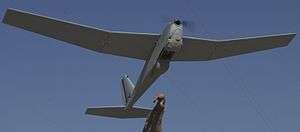AeroVironment RQ-20 Puma
| RQ-20 Puma | |
|---|---|
 | |
| RQ-20A launch by US Marine; his hand gives an idea of scale | |
| Role | Remote controlled UAS |
| Manufacturer | AeroVironment |
| First flight | 2007 |
| Introduction | 2008[1] |
| Primary users | United States Army United States Marine Corps United States Air Force |
| Number built | 1,000+ |
| Unit cost |
$250,000 |
The AeroVironment RQ-20 Puma is a small, battery powered, American hand-launched unmanned aircraft system produced by AeroVironment based in California. Primary mission is surveillance and intelligence gathering using an electro-optical and infrared camera.
Design and development
Previously selected for the United States Special Operations Command in 2008, in March 2012 the United States Army ordered the Puma All Environment (AE) and designated it the RQ-20A.[2] In April, the United States Marine Corps and United States Air Force placed a similar order for the RQ-20A.[3][4] Each military RQ-20A system has three air vehicles and two ground stations.[2] The Puma AE can operate under extreme weather conditions including temperatures ranging from −20 to 120 °F (−29 to 49 °C), wind speeds up to 25 knots (29 mph; 46 km/h), and an inch of rain per hour.[5]
On 26 July 2013, the Puma became one of the first unmanned aerial vehicles to be granted certification by the Federal Aviation Administration to fly in U.S. airspace for commercial purposes. AeroVironment expects one to be deployed to Alaska to support oil spill response crews and count wildlife. The Puma can safely accomplish observation missions in hazardous Arctic locations, which is safer, cheaper, and more environmentally friendly than using manned aircraft. Commercial certification was the result of previous military certification and the Congressionally-mandated opening of airspace over much of Alaska to small UAVs.[6] The FAA also certified the Boeing Insitu ScanEagle, also planned to be deployed to Alaska. Only three individual Pumas were certified with strict requirements: only one aircraft of the type is allowed airborne at any one time, they cannot fly through clouds or icing conditions, and they cannot take off or land during certain gust and wind conditions. The certifications did not mention line-of-sight control.[7]
On 8 June 2014, the Puma AE made its first flight for BP in Prudhoe Bay, Alaska, making it the first authorized unmanned commercial flight over land.[8]
The UK tested ISR packages compatible with the Puma AE on board the M80 Stiletto trials ship in November 2014 under Capability Demonstration 15-1.[9]
On 20 January 2016, a number of RQ-20 were captured by the Turkish army from the PKK. It is suspected that the Kurdish militants were able acquire these drones from their Syrian affiliates.[10]
In August 2016, AeroVironment announced the U.S. Navy had tested and deployed the RQ-20B Puma aboard a Flight I Guided Missile Destroyer, which included the company's Precision Recovery System to autonomously recover the aircraft aboard a ship. The Puma is also being utilized on Navy patrol craft in the Persian Gulf.[1]
Variants
- RQ-20A Puma
- Military designation for the Puma All Environment variant.
- RQ-20B
- Block 2 Puma AE, includes a more powerful and lighter propulsion system, lighter and stronger airframe, long endurance battery, precision inertial navigation system an improved user interface, and the new, all environment Mantis i45 gimbal sensor suite.[1]
- Solar Puma
- Puma AE powered by ultra-thin solar cells that increases endurance to 9 hours.[11] Production version planned for early 2014.[12]
- Enhanced Puma
- Upgrade of the RQ-20A Puma AE with more powerful propulsion system and new batteries that increase endurance by 75 percent to 3.5 hours, auxiliary payload bay to integrate payloads while keeping the video camera, precision navigation system with secondary GPS, and a redesigned durable fuselage with reinforced construction and improved aerodynamics. Available in early 2014.[13]
Operators
- United States Special Operations Command
- United States Army – 325 systems, one per infantry company and 18 per brigade[14]
- United States Marine Corps
- United States Navy
- United States Air Force
- National Oceanic and Atmospheric Administration[15]
Specification
Data from [16] Puma AE data sheet
General characteristics
- Length: 4 ft 7 in (1.4 m)
- Wingspan: 9 ft 2 in (2.8 m)
- Max takeoff weight: 13 lb (5.9 kg)
Performance
- Maximum speed: 52 mph; 45 kn (83 km/h)
- Minimum control speed: 23 mph; 20 kn (37 km/h)
- Range: 9 mi; 8 nmi (15 km)
- Endurance: 2 hours
See also
References
- 1 2 U.S. Army Places $20.4 Million Order for AeroVironment RQ-20A Puma AE Small Unmanned Aircraft Systems
- ↑ U.S. Marine Corps First to Procure Four Different AeroVironment Small Unmanned Aircraft Systems with $5.5 Million RQ-20A Puma Order
- ↑ AeroVironment Scores Another Small UAS Success - Ainonline.com, 27 April 2012
- ↑ Puma unmanned craft tested on USS Gonzalez - Upi.com, 23 September 2015
- ↑ AeroVironment's Puma becomes first UAV to earn FAA commercial certification, FlightGlobal, 26 July 2013
- ↑ FAA certifies two UAVs for commercial operations, FlightGlobal, 26 July 2013
- ↑ Drone at Prudhoe Bay makes first FAA-authorized unmanned commercial flight over land - adn.com, 10 June 2014
- ↑ Scott, Richard (26 October 2014). "Dstl plans unmanned ISR payload demonstration from Stiletto". IHS Jane's Defence Weekly.
- ↑ http://m.milliyet.com.tr/pkk-siginaginda-iha-bulundu-gundem-2182198/
- ↑ Allen McDuffee, "Launch This New 9-Hour Solar-Powered Drone from Your Shoulder", Wired, 13 August 2013
- ↑ AeroVironment Solar-Powered Puma AE Small Unmanned Aircraft Achieves Continuous Flight for More Than Nine Hours - sUASNews.com, 16 August 2013
- ↑ AeroVironment Introduces Block Upgrade to Puma AE Unmanned Aircraft System, Including 75 Percent Increase in Flight Duration - sUASNews.com, 21 October 2013
- ↑ Puma numbers - Strategypage.com, February 19, 2013
- ↑ - NOAA National Marine Sanctuaries
- ↑ Puma AE data sheet
External links
| Wikimedia Commons has media related to AeroVironment. |